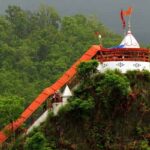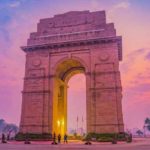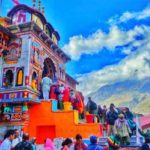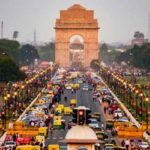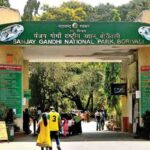A Visitor Guide To Jim Corbett National Park, nestled in the picturesque state of Uttarakhand, India, stands as a testament to nature’s untamed beauty. Established in 1936, it holds the distinction of being India’s oldest national park, named after the legendary hunter and conservationist Jim Corbett. Spanning over 520 square kilometers, this park is a haven for biodiversity enthusiasts and adventure seekers alike.
Renowned for its rich flora and fauna, Jim Corbett is a sanctuary for some of the most endangered and elusive species in the world. It is particularly famous for its population of Bengal tigers, making it a prime destination for wildlife enthusiasts hoping to catch a glimpse of these majestic creatures. Other inhabitants include leopards, Asian elephants, spotted deer, sambar deer, and over 600 species of birds, making it a paradise for birdwatchers A Visitor Guide To Jim Corbett National Park.
The park is divided into multiple zones, each offering a unique experience. Dhikala, Bijrani, Jhirna, and Durga Devi are some of the prominent zones, each with its distinct landscape and wildlife. Jeep safaris, elephant safaris, and canter safaris are popular ways to explore the park, allowing visitors to venture deep into the heart of the wilderness under the guidance of experienced naturalists.
Apart from thrilling wildlife encounters, Jim Corbett offers an array of activities to cater to diverse interests. Nature walks, treks, and birdwatching expeditions offer a chance to intimately connect with the natural surroundings. For the adventurous souls, the Kosi River presents opportunities for white-water rafting, adding an adrenaline rush to the experience.
In addition to its natural splendor, the park also houses the Corbett Museum at Kaladhungi, providing insight into the life and legacy of Jim Corbett Attractions.
With its unparalleled biodiversity and natural beauty, Jim Corbett National Park Tours remains a jewel in India’s conservation efforts. It stands as a sanctuary where humans can coexist harmoniously with the wild, serving as a reminder of the importance of preserving our natural heritage for generations to come.
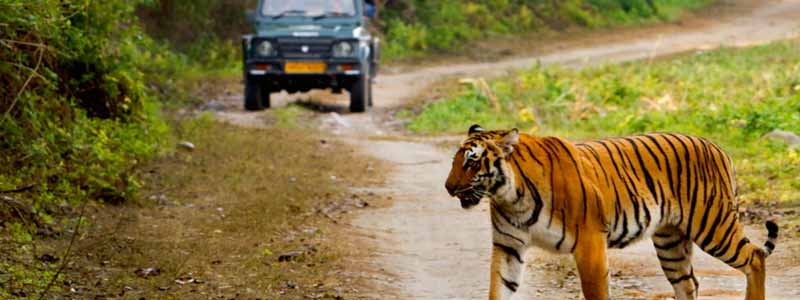
General Information
- Corbett National Park Area – 520 Square kilometers.
- Corbett Tiger Reserve Area -1318 Square kilometers
- Altitude – 385-1100 m above mean sea level.
- Annual rainfall – 1400-2800 mm.
- Temperature range – 4 degrees Celsius winter to 42 degrees Celsius during summer.
- Best Season – November to June.
History of Jim Corbett National Park
The History of Jim Corbett National Park goes along with the man who started this park for hunting purposes. He was strongly attached to wild animals, so he spent most of his time in this forest. And started teaching locals and guides about that park.
He spends his vacations and days off from work in his farmhouse, in addition to working. He once hunted the biggest man-eating tiger. He was so passionate that he hadn’t even married but spent his whole life in these forests A Visitor Guide To Jim Corbett National Park.
Corbett tiger reserve was named after him after he died. With its rich flora and fauna, it became the first tiger reserve in India. There’s still a lot to know about the History of Jim Corbett National Park.
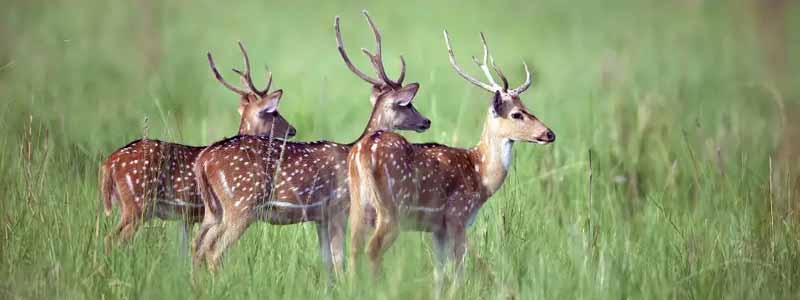
Jim Corbett Safari Timings
- Park Entry : 06:30 hours to 17:30 hours. (timing flexible as per season)
- Jeep Safaris : 06:30 to 10:30 Am and 01:30 to 05:30 Pm .(timing flexible as per season)
Jungle Safari in Jim Corbett National Park
Jim Corbett National Park offers unmatched options like jeep safari, elephant safari and canter safari for the tourists to begin their adventure wildlife trip into the forest.
Elephant Safari : Having a trip on an elephant’s back is fashionable and of great fun. The elephant safari starts at Durgadevi gate (north-eastern border) of the reserve and completes at Halduparao (north-western boundary). The charge of elephant safari for Indian is INR 500 / Person and for Foreigner it is INR 1500 / Person. One elephant is allowed to carry only 4 Persons at a time. It covers the Bijrani area. You can take an elephant ride from 6:30 AM – 10:00 AM in the Morning and from 1:30 PM – 5:30 PM in the Afternoon.
Jeep Safari : Discover the wilderness and varied species of flora & fauna of Jim Corbett National Park through jeep safari. It is the fast and comfortable mode to explore this area. The charge of jeep safari for Indian is INR 4000 / Jeep and for Foreigner, it is INR 7000 / Jeep. Only 6 persons are allowed in a single Jeep. It covers zones like Bijrani, Sitabani and Jhirna. For Durgadevi the charge differs it is INR 4500 / Jeep. Jeep safari can be enjoyed from 5:30 AM – 9:00 AM in the morning and 3:30 PM – 7:00 PM in the evening.
Canter Safari : If you want to explore Dhikala forest or staying in a resort, center safari is the only option. There are two canter safari services in a day- one is from 0600 Hrs (sunrise time) and the other at 1200 Hrs (afternoon). The 05 Hrs extensive ride through canter safari will give immense pleasure.
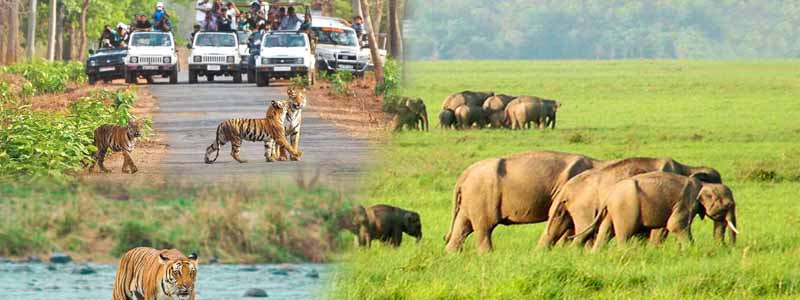
Tourist Zones of Jim Corbett National Park
The Tourist Zones: In order to promote tourism in the region Corbett National Park has been divided into five different zones. These are the marked buffer or core area of the park where visitors can be part of wildlife safari and can enjoy the intriguing behavior of the animals with bare eyes at proximity A Visitor Guide To Jim Corbett National Park.
Bijrani Safari Zone : Bijrani Zone is very popular tourist’s hub because of its abundant natural beauty and open grasslands. The entry gate of the zone is located at only 01 Km from Ramnagar city.
Jhirna Safari Zone : Jhirna is another important tourist zone in the Jim Corbett National park that is open for tourist round the year. Jhirna Gate is located at 16 km from Ramnagar city.
Dhela Safari Zone : Dhela is a new eco tourism zone in Corbett National Park included in tiger reserve zone in November 2014. This is the only area in the reserve’s buffer zone open to tourists in CTR. The zone is retaining the attention of large number of tourist because of its wealthy flora and fauna, open throughout the year, located at an approximate distance of 13 Km from Ramnagar City.
Dhikala Zone : Being the largest and most varied zone in Corbett, Dhikala is famous for its abundant natural beauty as well as offering the best sight for exotic fauna. The entry gate is 18 km away from Ramnagar city. Night stay inside the Dhikala Tourism Zone is highly recommended for the hard core wildlife enthusiasts.
Durga Devi Zone : Located on the north-eastern boundary of the Jim Corbett National Park, Durga Devi zone is the heaven on planet earth for those who are fond of bird watching. Entry gate is located at an approximate distance of 36 km from Ramnagar city.
Sitabani Buffer Zone : Sitabani Zone doesn’t fall under the Corbett Tiger Reserve area. If you are fond of serene ambiance of the natural beauty, must visit Sitabani area A Visitor Guide To Jim Corbett National Park.
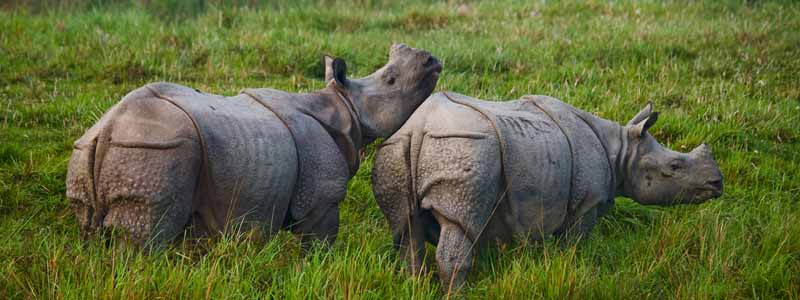
Places to visit in Jim Corbett Park
Here are some popular tourist attractions-
Corbett Waterfall – a 66-feet high waterfall with mesmerizing views
Garjia Temple – a temple on a rock placed right in the middle of the River Kosi
Corbett Museum – the heritage bungalow of Jim Corbett
Durga Mandir – an intricately designed temple dedicated to Goddess Durga
Sitabani Forest Reserve – a naturally enclosed site opposite the Jim Corbett Park
Kalagarh Dam – a beautiful dam encompassed by a picturesque landscape
Kosi River– quenches the thirst of a large number of animals
Best Time to Visit Jim Corbett National Park
Spanned over beautiful areas of Pauri Garhwal, Almora and Nainital of Uttarakhand state in India, Jim Corbett National Park is a large and appealing site and is amongst the oldest parks in India. This park is mainly recognised for Project Tiger which is a project on India’s endangered Bengal tiger. So, it is not just a park, but a big and renowned tiger reserve as well which covers an area of 1318.54 sq.km in which 520 sq. km is the main area and remaining part is buffer area. The park is named after Col. Jim Corbett since 1956 A Visitor Guide To Jim Corbett National Park.
So, the visit to Jim Corbett National Park is truly memorable and unforgettable. It remains open from the mid of November to the mid of June months. However, there is a Jhirna zone in the park that remains open for whole year long. The famous Bijrani zone of this park welcomes the visitors from mid of October to mid of June months and Dhikala zone allows visitors to visit inside from November 15 to mid of June. During monsoon period, the road of Dhikala and Bijrani zones get completely washed away. Moreover, after the sunset, the gates of the park get closed and no drive out is allowed that time.
How to Reach Jim Corbett?
The Jim Corbett national park is located in the Nainital district of Uttarakhand. It is connected to all important cities via a network of highways and well-maintained roads. Here are some ways to travel to the national park:
By Train : Ramnagar railway station is the closest railway station to Corbett national park. The train station is at a distance of around 3 km from the national park. You can book a cab from Ramnagar to Corbett national park and get there within a few minutes A Visitor Guide To Jim Corbett National Park.
By Flight : The nearest airport to Jim Corbett national park is in Dehradun. The Jolly Grant Airport in Nagpur has flights from most major cities in India. It is at a distance of around 170 km from the park. You can book a Dehradun to Jim Corbett park cab and reach within 3-4 hours.
By Road : You can reach the national park from most major cities in India with ease. Here is the distance and travel time from some nearby cities:
- Dehradun – 170 km and a travel time of 3-4 hours
- Delhi – 240 km and a travel time of around 5 hours
- Bareilly – 160 km and a travel time of around 3 hours
- Patiala – 380 km and a travel time of 6-7 hours


